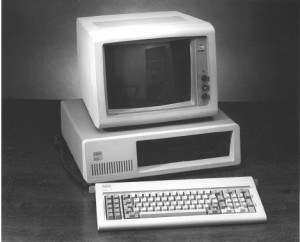Talk about longevity. Thirty years ago to this month, PCWorld published its very first print issue, a 310-page magazine loaded with essential news, reviews, and features about IBM PCs and compatible “clones.”
The content inside the March 1983 issue of PC World was exceedingly quaint–even borderline comical, as the images in our accompanying slideshow prove. But once you take stock of PCWorld’s entire 30-year history, you begin to develop a profound appreciation for just how dramatically the PC platform has evolved–and how it has influenced the greater world of consumer electronics, from music players to smartphones to any device that’s connected to the Internet and geared toward social sharing.
We commemorate PCWorld’s 30-year history with a trip down memory lane, calling out the most pivotal PC-related events and product releases that occurred in each calendar year from 1983 to 2012. Keep in mind that these aren’t necessarily the 30 most important PC landmarks of the last 30 years, but rather the biggest highlights in each individual year.
Think we missed something critically important? Let us know in the comments section below!
1983
Compaq Portable debuts: Founded during the prior year, Compaq makes its mark on the industry by releasing its first PC–the first luggable IBM-compatible, and a harbinger of the age of mobile computing. Compaq, of course, would become a huge player in the PC industry, only to be acquired by HP two decades later.
1984
PCs Limited starts up: A college student named Michael Dell launches a small business in his dorm room, building custom PCs. His little endeavour is destined to become one of the biggest companies in the industry, getting into printers, servers, and networking gear too.
1985
Windows 1.0 ships: After initially discussing Windows in 1983, PCWorld scarcely gives the software a mention in 1985 or 1986. No one predicts big things for this somewhat clunky visual file-management utility, the precursor to full-fledged OS greatness.
1986
Intel delivers the 386: The first 32-bit PC processor, the 386 offers the ability to address seemingly limitless amounts of memory. (Hah! Yes. Well, it certainly felt limitless back then.) The 386 inspires a new generation of software, including revamped versions of Windows.
1987
VGA arrives: Video Graphics Array premiers along with IBM’s ill-fated PS/2 line. VGA survives to become a de facto standard, remaining the lowest common denominator in Windows, and on graphics cards and monitors. Indeed, go check your desktop display. It almost certainly includes a VGA connector waiting for some legacy-standard loving.
1988
EISA appears: Created in response to IBM’s proprietary Micro Channel interface, EISA serves mainly to support older ISA (PC-AT) expansion cards. EISA allows PC makers to thrive until more advanced standards (such as VESA local bus, PCI and AGP) come into play.
1989
HTML is invented: Tim Berners-Lee creates HyperText Markup Language. A year later, he uses HTML to build the core of what would become the World Wide Web.
1990
Windows 3.0 ships: Transforming a simple graphical file manager into the main way that users interact with their PCs, Windows 3.0 enables a staggering 16MB of addressable memory. Applications vendors support it in droves.
1991
PCI Bus is developed: The Peripheral Component Interconnect, created by Intel, makes life vastly easier for PC users and manufacturers. PCI (the eventual progenitor of PCI Express) permits autoconfiguration of interface cards, improved speeds, and enhanced interoperability.
1992
AMD wins legal right to sell x86 clone CPUs: In 1982, to satisfy IBM’s desire for a second source of x86 chips, Intel licenses AMD to make them. Intel cancels the agreement in 1986, however, and AMD disputes the decision, prompting a protracted legal battle. AMD wins the right to continue making x86 CPUs in 1992, though court appeals last into 1994. AMD’s competition eventually drives Intel to abandon the Pentium 4 for its more power-efficient Core CPUs.
1993
Mosaic Web browser is released: Built at the National Center for Supercomputing Applications, Mosaic is not the earliest graphical Web browser, but it rapidly becomes the most popular, and serves as the precursor to all modern Web browsers. Mosaic’s lead programmer, Marc Andreessen, goes on to found Netscape.
1994
Windows 95 launches: Windows 95 turns what was a shell on top of DOS into a complete operating system. The new release effectively kills off MS-DOS. Through clever programming, Windows 95 spans both 32-bit and 16-bit applications. One of its innovations–which initially puzzles users–is the Start menu.
1995
First significant 3D chips ship: The first instances of truly gaming-capable 3D accelerators, the Rendition Vérité 1000 and the 3dfx Voodoo, set the stage for a new generation of graphics cards. It’s a development that drives a stake into the heart of old-school VGA and “Windows accelerator” cards.
1996
USB emerges: In contrast to serial and parallel ports, which can be finicky and headache-inducing, USB enables self-configuring devices, vastly simplifying the chore of hooking up keyboards, mice, and cameras, and spawning the USB flash memory key industry.
1997
DVD players and discs go on sale: DVD drives eventually come to computers and become the last standard optical drive to see almost universal adoption, as Blu-ray later fails to achieve widespread market penetration in PCs.
1998
DMCA passes: The Digital Millennium Copyright Act, which prohibits the reverse engineering of content-protection schemes, becomes law. The DMCA exempts Internet sites from copyright liability provided that they comply with DMCA takedown notices.
1999
802.11a/b standards are ratified: The first 802.11 standards for wireless networking are adopted, and the Wi-Fi Alliance is founded to promote and certify products based on the standard. Wi-Fi goes on to become one of the widest-implemented networking technologies, and is hugely popular with both business users and consumers.
2000
Electronic Arts ships The Sims: Designed by Will Wright, The Sims allows players to guide simulated people through their everyday lives. Though its game play is somewhat snoozy, The Sims promptly claims the throne as the bestselling computer game of all time, consuming countless hours as players try to optimise the lives of their artificial creations.
2001
Windows XP arrives: Merging Windows 2000 and ME into a unified, 32-bit operating system, Windows XP becomes the most successful operating system in Microsoft’s history.
2002
Tablet PCs debut: Although tablets existed well before Microsoft’s Tablet PC specifications, those based on Windows XP Tablet PC Edition are the first such devices to gain widespread attention. Although they fail to achieve significant market penetration, they succeed in laying the groundwork for Windows 8 tablets.
2003
AMD delivers the first 64-bit x86 CPU: Beating Intel to the punch, AMD ships the Athlon 64, which offers both 64-bit registers and 64-bit memory addressing in its architecture. Microsoft starts building a version of Windows to support 64-bit, spurring Intel to deliver its own x86-64 product two years later.
2004
Intel Pentium M arrives: Developed by Intel’s Israel-based design team, the Pentium M CPU is a heavily modified Pentium III that emphasizes power efficiency over raw clock speed (unlike the Pentium 4, Intel’s then mainstay). The M serves as the precursor to the company’s Core processor line.
2005
Apple switches to Intel CPUs: With its personal computers hitting a performance and power-efficiency dead end due to their reliance on PowerPC CPUs, Apple adopts Intel’s processors and natively ports its OS and applications to Intel’s architecture.
2006
Intel ships the Core 2 Duo: The chip maker puts its Pentium 4 architecture to rest with the Core 2 Duo CPU. Even though the new processor runs at a lower clock speed, its greater instruction-set efficiency allows Intel to retake the performance crown from arch rival AMD. Core 2 Duo uses substantially less power and runs cooler than AMD’s offerings, too.
2007
Apple iPhone premieres: Apple’s iPhone reinvents smartphones, becoming hugely successful and eventually prompting Google to enter the mobile OS business. Microsoft takes note of the iPhone’s success too, later incorporating touch and user-interface simplicity into its own PC and mobile operating systems.
2008
Laptops outsell desktops: Mobility becomes the primary focus of computer design, as the widespread adoption of Wi-Fi and dropping prices encourage users to flock to laptops. In many instances, a laptop becomes the only PC that a person owns.
2009
Windows 7 is released: After the critical, if not financial, failure of Windows Vista, Windows 7 proves to be the comeback that Microsoft needs. Substantially streamlined and more responsive than its predecessor, Windows 7 is the OS that allows Microsoft to pull the plug on Windows XP. Windows 7 also leads the transition from 32-bit to 64-bit computing, eventually selling more 64-bit copies than 32-bit versions.
2010
Apple unleashes the iPad: In contrast to Microsoft’s drawn-out effort to develop iterations of its Tablet PC, Apple succeeds in dominating the tablet market overnight. The key: The iPad isn’t a PC that acts as a tablet, but a pure tablet. It also gives users an incredibly simple way to buy low-cost apps, building a huge ecosystem of applications in a short time.
2011
Intel launches Ultrabooks: Prompted by PC makers’ failure to replicate the design success of Apple’s MacBook Air, Intel establishes rough guidelines for ultraportable PCs, backing up the Ultrabook standard with a strong financial push, and helping PC companies design and build the laptops. Ultrabook sales figures prove to be a mixed bag, but ultrathin laptops are clearly here to stay.
2012
Windows 8 debuts: Microsoft’s most divisive OS since Windows 95, Windows 8 introduces the Microsoft Store for apps, and drops the Start menu in favour of a Start screen that occupies the entire display. It generates tremendous controversy, and users either love it or hate it.






